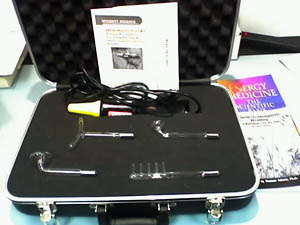|

|
|
|
|
June 2016 
|
COFE8 is just around the
corner, with two days of great speakers addressing energy,
propulsion, and bioenergetics. We are honored to have famed
medical doctor, Norm Shealy, MD, PhD, inventor of the TENS
pain device, to give two lectures. One will be to the joint
audience of the ExtraOrdinary Technology Conference and COFE8,
while the other will be just to our group at the concurrent
COFE8. Visit www.futurenergy.org for
more info where you can learn about all of the COFE8 topics
dedicated to our energy future, at COFE8, the end of July, 2016.
All of our speakers are listed online and registration is now
open. (IRI was the first organization to publicize the "future
energy" concept in 1999 with our first COFE.) IRI Members
get 10% off too. By the way, IRI and last year's COFE7 was
just mentioned in a new book on inertial propulsion by Dennis
Allen which will be published later this summer.
Our first story this month piggy
backs on the solar plane that is making a world record
circumnavigating the globe as this eNews is going out. NASA gets
the credit for the all-electric, zero-emission X-57 aircraft that
uses less energy and can cruise at higher speeds than similar aircraft
of today. It also has an interesting propeller design that adds
to its efficiency.
The second story could be the
blueprint for power plants in West Virginia and other coal and
natural gas harvesting states in the US. Rather than discouraging
folks with lots of coal and natural gas to bring up, turning the
CO2 into stone is a "surprising chemical
transformation" which lets the fossil fuel burners have
their concentrated energy source and burn it too! The article is
in the leading journal Science
and also in the popular Scientific
American . They aim at decarbonizing our energy
infrastructure!
The third story celebrates zero
point energy once again as Casimir forces are finally able to be
measured. However, just as Dr. Pinto warned us at COFE3, the
journals like "Van Der Waals" forces but shun the other
two just mentioned even though virtual particles are what keep
the gecko sticking to a surface. This rose by any other name is
still caused by the Quantum Vacuum! Using a single xenon atom,
physicists have verified the fundamental quantum mechanics giving
stability to all matter with the influx of a half-quantum of
energy.
Our fourth story comes from one
of my favorite journals, the Energy Harvesting Journal, which has
become very popular in the past few years, for obvious reasons.
Now we find that a nanocavity can improve ultrathin solar
panels with improved light capturing capability, with mirrors of
aluminum oxide and closed paths for the light to follow. The
design absorbs almost 70 per cent of the incoming light, which is
extraordinary. And did I mention the panels are flexible too?
The last story gives us a
glimpse of what is possible undersea, with wind turbines that
operate underwater. The Aquantis company www.Aquantistech.com will
be installing 200 MW undersea turbines in the Gulf Stream in just
a couple of years, with investments from Microsoft, the USDOE,
Mitsubishi, Facebook, Google, and more.
|
|
|
Our Best Selling nano
second PEMFdevice
|
|
|
Our most
popular HIgh voltage device
|
|
|
|
Best NanoSecond PEMF for
arthritis, bone issues
|
|
|
|
1) NASA's New Electric Plane
Ushers a New Era of Clean Aviation
|
|
By
Matt McFarland,
Washington Post,
June 16, 2016
NASA is developing an electric plane to accelerate
the introduction of zero-emission aircraft that use less energy
and cruise at higher speeds than the aircraft of today. If
successful, the plane could become a significant first step
toward a new era of more efficient and environmentally friendly
air travel.
The electric plane, which NASA is calling the X-57,
will seat only a pilot. NASA is also planning five larger planes
capable of carrying far more passengers and cargo.
The plane will include 14 motors that power
propellers on an unusually thin wing. Typically such a narrow
wing would be out of the question, because planes need the lift
that a broad wing provides during takeoff and landing. But
because NASA has a cluster of propellers lining the wing, more
air will be blowing across the wing, providing extra lift.
While all 14 motors would operate during takeoff and
landing, only two would be needed once the plane is cruising high
in the sky.
The X-57 will have a limited range of about 100
miles and an hour or less of flight time. But the agency is thinking
long-term and counting on advances in battery technology to
dramatically augment the plane's power in future years.
"If batteries continue to be on the same rapid
increase in energy density that they have been on over the past
10 years or so, one can envision five to 10 years out in the
future the battery technology would be such that this particular
aircraft could be enabled for a commercial-type aspect,"
said Matt Redifer, the chief engineer on the project.
NASA has a four-year timeline for developing
the aircraft. Its first step will be to convert a Tecnam P2006T,
an Italian twin-engine light aircraft, to a purely electric
powered plane.
NASA hopes to show that switching to a distributed
electric system relying on 14 motors will be five times as energy
efficient as a typical plane.
The development of an electric plane could prove
valuable amid concerns about climate change. Commercial aircraft
contribute 11 percent of U.S. transportation emissions and 3
percent of all U.S. emissions, according to the Environmental
Protection Agency.
This is the first experimental plane NASA has
designed itself in a decade. The organization's history in
experimental planes dates to 1947 with the first piloted airplane
to break the sound barrier.
NASA is nicknaming the X-57 "Maxwell," in
honor of James Clerk Maxwell, the 19th-century Scottish physicist
who is known for his work in electromagnetism.
NASA administrator Charles Bolden will be formally
announcing the project Friday at a conference.
Related Story
|
|
2) In a First, Iceland Power
Plant turns Carbon Emissions to Stone
|
|
By Phys.org Newsletter
June 2016
Scientists and engineers working at a major power
plant in Iceland have shown for the first time that carbon
dioxide emissions can be pumped into the earth and changed
chemically to a solid within months-radically faster than anyone
had predicted. The finding may help address a fear that so far
has plagued the idea of capturing and storing CO2 underground:
that emissions could seep back into the air or even explode out.
A study describing the method appears this week in the leading
journal Science.
The Hellisheidi power plant is the world's largest
geothermal facility; it and a companion plant provide the energy
for Iceland's capital, Reykjavik, plus power for industry, by
pumping up volcanically heated water to run turbines. But the
process is not completely clean; it also brings up volcanic
gases, including carbon dioxide and nasty-smelling hydrogen
sulfide.
Under a pilot project called Carbfix, started in
2012, the plant began mixing the gases with the water pumped from
below and reinjecting the solution into the volcanic basalt
below. In nature, when basalt is exposed to carbon dioxide and
water, a series of natural chemical reactions takes place, and
the carbon precipitates out into a whitish, chalky mineral. But
no one knew how fast this might happen if the process were
harnessed for carbon storage. Previous studies have estimated
that in most rocks, it would take hundreds or even thousands of
years. In the basalt below Hellisheidi, 95 percent of the
injected carbon was solidified within less than two years.
"This means that we can pump down large amounts
of CO2 and store it in a very safe way over a very short period
of time," said study coauthor Martin Stute, a hydrologist at
Columbia University's Lamont-Doherty Earth Observatory. "In
the future, we could think of using this for power plants in
places where there's a lot of basalt-and there are many such
places." Basically all the world's seafloors are made of the
porous, blackish rock, as are about 10 percent of continental
rocks.
Scientists have been tussling for years with the
idea of so-called carbon capture and sequestration; the 2014
report of the Intergovernmental Panel on Climate Change suggests
that without such technology, it may not be possible to limit
global warming adequately. But up to now, projects have made
little progress. It has been tried at only a handful of sites,
and most experiments have involved pumping pure carbon dioxide
into sandstone, or deep, salty aquifers. Here, it is hoped,
pressure and solid layers of caprock above would seal in the
waste. But scientists have worried that any miscalculation could
result in emissions making their way back up through fractures,
or that natural earthquakes or tremors caused by the injection
itself could rupture subterranean reservoirs. A coal-fired power
plant in Saskatchewan that currently runs North America's only
large-scale operation at a generating station has been plagued by
technical problems-and the captured carbon dioxide is being sent
to oil producers who inject it into ailing wells to pressure out
more oil, which produces more carbon dioxide when burned.
In 2007 Hellisheidi's operator, Reykjavik Energy,
joined with a consortium including Columbia and the universities
of Copenhagen and Iceland to get rid of its CO2 emissions, along
with the hydrogen sulfide, which was plaguing the area. The plant
produces 40,000 tons of CO2 a year-5 percent the emissions of an
equivalent coal-fired plant, but still considerable. Lab
experiments showed that, unlike the sedimentary rocks
that most other projects have used for injection, the local
basalt contains plenty of calcium, iron and magnesium, which are
needed to precipitate out carbon. Experiments showed that large
amounts of water would also have to be added to make the reaction
go-another departure from previous projects, which have just
pumped down pure carbon dioxide.
|
|
3) Measuring Van Der Waals
(Casimir) Forces
|
|
Nanophysics Newsletter
June 2016
Physicists
at the Swiss Nanoscience Institute and the University of Basel
have succeeded in measuring the very weak van der Waals forces
between individual atoms for the first time. To do this, they
fixed individual noble gas atoms within a molecular network and
determined the interactions with a single xenon atom that they
had positioned at the tip of an atomic force microscope. As
expected, the forces varied according to the distance between the
two atoms; but, in some cases, the forces were several times
larger than theoretically calculated. These findings are reported
by the international team of researchers in Nature
Communications.
Van der Waals forces act between non-polar atoms and
molecules. Although they are very weak in comparison to chemical
bonds, they are hugely significant in nature. They play an
important role in all processes relating to cohesion, adhesion,
friction or condensation and are, for example, essential for a
gecko's climbing skills.
Van der Waals interactions arise due to a temporary
redistribution of electrons in the atoms and molecules. This
results in the occasional formation of dipoles, which in turn
induce a redistribution of electrons in closely neighboring
molecules. Due to the formation of dipoles, the two molecules
experience a mutual attraction, which is referred to as a van der
Waals interaction. This only exists temporarily but is repeatedly
re-formed. The individual forces are the weakest binding forces
that exist in nature, but they add up to reach magnitudes that we
can perceive very clearly on the macroscopic scale - as in the
example of the gecko.
Fixed within the nano-beaker
To measure the van der Waals forces, scientists in
Basel used a low-temperature atomic force
microscope with a single xenon atom on the tip. They then
fixed the individual argon, krypton and xenon atoms in
a molecular network. This network, which is self-organizing under
certain experimental conditions, contains so-called nano-beakers
of copper atoms in which the noble gas atoms are held
in place like a bird egg. Only with this experimental set-up is
it possible to measure the tiny forces between microscope tip and
noble gas atom, as a pure metal surface would allow the noble gas
atoms to slide around.
The researchers compared the measured forces with
calculated values and displayed them graphically. As expected
from the theoretical calculations, the measured forces fell
dramatically as the distance between the atoms increased. While
there was good agreement between measured and calculated curve
shapes for all of the noble gases analyzed, the absolute measured
forces were larger than had been expected from calculations
according to the standard model. Above all for xenon, the
measured forces were larger than the calculated values by a
factor of up to two.
|
|
4) Nanocavity May Improve
Ultrathin Solar Panels
|
|
Energy Harvesting
Journal, June 2016
The future of movies and manufacturing may be in
3-D, but electronics and photonics are going 2-D; specifically,
two-dimensional semiconducting materials. One of the
latest advancements in these fields centers on molybdenum
disulfide (MoS), a two-dimensional semiconductor that, while
commonly used in lubricants and steel alloys, is still being
explored in optoelectronics.
Recently, engineers placed a single layer of MoS
molecules on top of a photonic structure called an optical
nanocavity made of aluminum oxide and aluminum. (A nanocavity is
an arrangement of mirrors that allows beams of light to circulate
in closed paths. These cavities help us build things like lasers
and optical fibers used for communications.) The results,
described in the paper "MoS monolayers on nanocavities:
enhancement in light-matter interaction" published in the
journal 2D Materials, are promising. The MoS nanocavity can
increase the amount of light that ultrathin semiconducting
materials absorb. In turn, this could help industry to continue
manufacturing more powerful, efficient and flexible electronic
devices.
"The nanocavity we have developed has
many potential applications," says Qiaoqiang Gan, PhD,
assistant professor of electrical engineering in the University
at Buffalo's School of Engineering and Applied Sciences. "It
could potentially be used to create more efficient and flexible
solar panels, and faster photodetectors for video cameras and
other devices. It may even be used to produce hydrogen fuel
through water splitting more efficiently."
A single layer of MoS is advantageous because unlike
another promising two-dimensional material, graphene, its bandgap
structure is similar to semiconductors used in LEDs, lasers and
solar cells. "In experiments, the nanocavity was able
to absorb nearly 70 percent of the laser we projected on it. Its
ability to absorb light and convert that light into available
energy could ultimately help industry continue to more
energy-efficient electronic devices," said Haomin Song, a
PhD candidate in Gan's lab and a co-lead researcher on the paper.
Industry has kept pace with the demand for smaller,
thinner and more powerful optoelectronic devices, in part, by
shrinking the size of the semiconductors used in these devices.
A problem for energy-harvesting optoelectronic devices,
however, is that these ultrathin semiconductors do not absorb
light as well as conventional bulk semiconductors. Therefore,
there is an intrinsic tradeoff between the ultrathin
semiconductors' optical absorption capacity and their thickness.
The nanocavity, described above, is a
potential solution to this issue
|
|
5) New Wave of Under the Sea
Renewable Energy Sources Coming
|
|
By L.
Johnson , Trending Tech June 16, 2016
We have all seen the many wind turbines and solar
panels that are set up in the countryside and peoples homes, but
what about underwater turbines? Although this is not an
entirely new area of renewable energy, thanks to a man named Jim
Dehlsen, it may be about to receive the marketing, and
subsequently investment opportunities need to get really this
thing going.
Having many years experience in wind energy, Mr.
Dehlsen decided to take that knowledge and use it in an area that
is not so popular yet and to revolutionize it. He realized
the potential the waters of the world provide us with in terms of
an energy source and went at it full steam to try and convert
this untapped energy into something we could all benefit from
using underwater turbines.
The company that was created to put forward Jim's
ideas is called Aquantis and is based in Santa Barbara,
California. With turbines already in production and being
distributed to Wales and the Isle of Wight in 2018, the
start of something big could be just around the corner.
Soon after the first turbines have been erected, the biggest will
be at a site in the Gulf Stream in 2019/2020 and will
consist of a 200-megawatt field of marine turbines.
Theses gigantic turbines work by gathering the
energy created by waves, tidal currents and steady
currents. Because there is always a constant flow of water,
there will always be a constant flow of energy being
created. This free source of energy obviously helps to set
against the initial set up costs of the underwater
turbines. Others that are currently in operation by
competitors work differently to Aquantis as they tend to dig deep
into the ocean floor opposed to sitting on the ocean bed,
increasing the costs by a huge amount.
Microsoft has already had recognized the potential
that Jim and co have to offer and have just finished a combined
testing experiment that consisted of constructing an underwater
chamber that housed data on behalf of Microsoft. It was
carried out over a period of 105 days and was deemed to be a
success, so it could be the first of many valuable formed
partnerships Aquantis will soon acquire with Facebook,
Google and Apple already having been approached.
Investments are coming in from all over with people
and companies wanting to get on board with Aquantis, and much of
that is down to Mr. Dehlsen himself and his extensive knowledge
and expertise in this field. Department of Energy grants
have already been awarded to the team, and even Mitsubishi Heavy
Industries has claimed a little piece of investment.
While many people are eager to carry forward this
work of the progression of underwater turbines and 'wave power',
there are still a few concerns as to the actual running costs
compared to solar or wind power as well as the worry that the
noise may confuse sea life.
Whatever peoples concerns are it is evident that
this is an avenue of renewable energy that has not yet been
explored thoroughly. But, with more time and research
devoted to this field, there is no reason to say the efficiency
can not improve, just as solar power systems have. By
introducing the use of marine energy, we are opening up another
branch of technology that may just help save the planet and could
serve almost 10 percent of the USA within the next fifteen years.
|
|
If you
enjoy this service, please consider making a donation by
clicking on the button below. We are a 501 (C)3 Non Profit
Institute and your donations are fully deductible to the maximum
allowed by law.
|
|
|
|
|
|

|
|
![]()




















